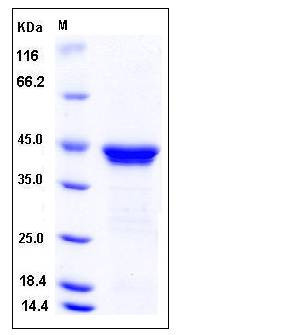Human RRM2B / P53R2 Protein (His Tag)
MTDPS8A,MTDPS8B,P53R2
- 100ug (NPP4224) Please inquiry
| Catalog Number | P13150-H07E |
|---|---|
| Organism Species | Human |
| Host | E. coli |
| Synonyms | MTDPS8A,MTDPS8B,P53R2 |
| Molecular Weight | The recombinant human RRM2B consisting of 366 amino acids and has a calculated molecular mass of 42.6 kDa. It migrates as a 43 kDa band in SDS-PAGE under reducing conditions as predicted. |
| predicted N | Met |
| SDS-PAGE |  |
| Purity | > 92 % as determined by SDS-PAGE |
| Protein Construction | A DNA sequence encoding the human RRM2B (Q7LG56-1) (Met 1-Phe 351) was expressed, with a polyhistide tag at the N-terminus. |
| Bio-activity | Measured by its ability to bind TP53 in a functional ELISA. |
| Research Area | Cardiovascular |Heart |Apoptosis |p53 Pathway |
| Formulation | Lyophilized from sterile PBS, 30% glycerol, pH 8.5 1. Normally 5 % - 8 % trehalose and mannitol are added as protectants before lyophilization. Specific concentrations are included in the hardcopy of COA. |
| Background | Ribonucleoside reductase subunit M2B, also known as RRM2B or p53R2, is an enzyme belonging to the iron-dependent ribonucleotide reductase (RNR) enzyme family which is essential for DNA synthesis. Ribonucleotide reductase (RNR) is an enzyme that catalyzes the formation of deoxyribonucleotides from ribonucleotides and plays a critical role in regulating the total rate of DNA synthesis so that DNA to cell mass is maintained at a constant ratio during cell division and DNA repair. RRM2B is a phosphorylated protein. It is hypothesized that RRM2B activity can be regulated at the posttranslational level in response to DNA damage. RRM2B has previously been shown to be essential for the maintenance of mtDNA copy number and its candidacy for tumor suppression has been evaluated in several mutational analyses of different cancer types. However, the contribution of RRM2B to the DNA damage response has been questioned because its transcriptional induction upon DNA damage is not rapid enough for prompt DNA repair. Instead, ATM-mediated phosphorylation has been suggested to regulate the DNA repair activity of RRM2B posttranslationally. In addition, a defect in RRM2B can induce a mild muscle disease of adult onset through disturbance of mitochondrial homeostasis but that this defect does not appear to be oncogenic. |
| Reference |
